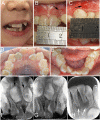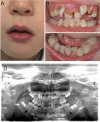The dental phenotype of primary dentition in SATB2-associated syndrome: a report of three cases and literature review
- PMID: 36457071
- PMCID: PMC9717407
- DOI: 10.1186/s12903-022-02594-4
The dental phenotype of primary dentition in SATB2-associated syndrome: a report of three cases and literature review
Abstract
Background: SATB2-associated syndrome (SAS; OMIM: 612,313) is an autosomal dominant inherited multisystemic disorder caused by several variants of the SATB2 gene. SAS is characterized by intellectual disability, developmental delay, severe speech anomalies, craniofacial anomalies, and dental abnormalities. Here, we report the dental phenotype of primary dentition of three Chinese children with SAS.
Case presentation: All three cases with SAS showed intellectual disability, speech and language anomalies, and palate anomalies. For the dental phenotype, all three cases showed macrodontia, crowded dentition, extensive caries, periapical abscesses and fistulas. Radiographs showed the wide-open root apex of deciduous teeth, loss of mandibular second bicuspids, delayed root formation of permanent teeth, rotated teeth, and taurodontism. Sanger sequencing of case 1 showed that there was a heterozygous code shift variation, c1985delT (p.F662Sfs*9) in the SATB2 gene, which has not been reported in literature. Root canal therapy, carious restoration, and teeth extraction were managed promptly, while preventive dental care was given regularly.
Conclusions: The dental phenotype of primary dentition in SAS may show macrodontia, crowded dentition, severe caries, wide-open root apex of deciduous teeth, loss of mandibular second bicuspids, delayed root formation of permanent teeth, rotated teeth, and taurodontism. Regular oral hygiene instructions and preventive dental care are both required.
Keywords: Dental abnormalities; SATB2 gene; SATB2-associated syndrome.
© 2022. The Author(s).
Conflict of interest statement
The authors declare that there is no conflict of interest.
Figures



Similar articles
-
Dental radiographic findings in 18 individuals with SATB2-associated syndrome.Clin Oral Investig. 2018 Nov;22(8):2947-2951. doi: 10.1007/s00784-018-2702-9. Epub 2018 Oct 12. Clin Oral Investig. 2018. PMID: 30315422
-
Genotype and phenotype in 12 additional individuals with SATB2-associated syndrome.Clin Genet. 2017 Oct;92(4):423-429. doi: 10.1111/cge.12982. Epub 2017 Mar 7. Clin Genet. 2017. PMID: 28139846
-
Craniofacial and dental characteristics of three Japanese individuals with genetically diagnosed SATB2-associated syndrome.Am J Med Genet A. 2023 Jul;191(7):1984-1989. doi: 10.1002/ajmg.a.63225. Epub 2023 May 4. Am J Med Genet A. 2023. PMID: 37141439
-
SATB2-Associated Syndrome Due to a c.715C>T:p(Arg239*) Variant in Adulthood: Natural History and Literature Review.Genes (Basel). 2023 Apr 8;14(4):882. doi: 10.3390/genes14040882. Genes (Basel). 2023. PMID: 37107640 Free PMC article. Review.
-
SATB2-associated syndrome: Mechanisms, phenotype, and practical recommendations.Am J Med Genet A. 2017 Feb;173(2):327-337. doi: 10.1002/ajmg.a.38022. Epub 2016 Oct 24. Am J Med Genet A. 2017. PMID: 27774744 Free PMC article. Review.
Cited by
-
Dental Tissue Density in Healthy Children Based on Radiological Data: Retrospective Analysis.JMIRx Med. 2024 Jun 20;5:e56759. doi: 10.2196/56759. JMIRx Med. 2024. PMID: 38904484 Free PMC article.
-
Region-specific gene expression profiling of early mouse mandible uncovered SATB2 as a key molecule for teeth patterning.Sci Rep. 2024 Aug 6;14(1):18212. doi: 10.1038/s41598-024-68016-3. Sci Rep. 2024. PMID: 39107332 Free PMC article.
-
Quantitative Phenotype Morbidity Description of SATB2-Associated Syndrome.Hum Mutat. 2023 Apr 26;2023:8200176. doi: 10.1155/2023/8200176. eCollection 2023. Hum Mutat. 2023. PMID: 40225157 Free PMC article.
-
Autism spectrum disorders and childhood caries: a comprehensive Mendelian randomization study.BMC Pediatr. 2025 Jul 2;25(1):484. doi: 10.1186/s12887-025-05839-7. BMC Pediatr. 2025. PMID: 40597832 Free PMC article.
References
-
- Bengani H, Handley M, Alvi M, Ibitoye R, Lees M, Lynch SA, Lam W, Fannemel M, Nordgren A, Malmgren H, et al. Clinical and molecular consequences of disease-associated de novo mutations in SATB2. Genetic Med Offic J Am College Med Genetic. 2017;19(8):900–908. doi: 10.1038/gim.2016.211. - DOI - PMC - PubMed
Publication types
MeSH terms
Substances
Supplementary concepts
LinkOut - more resources
Full Text Sources
Miscellaneous

